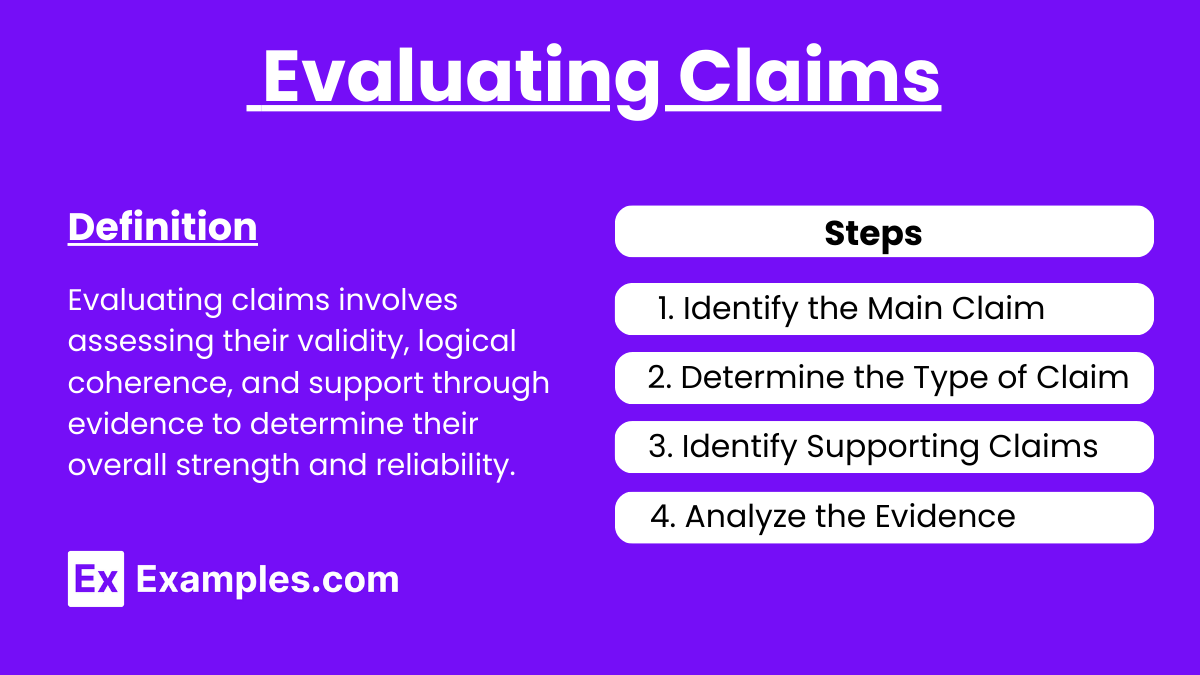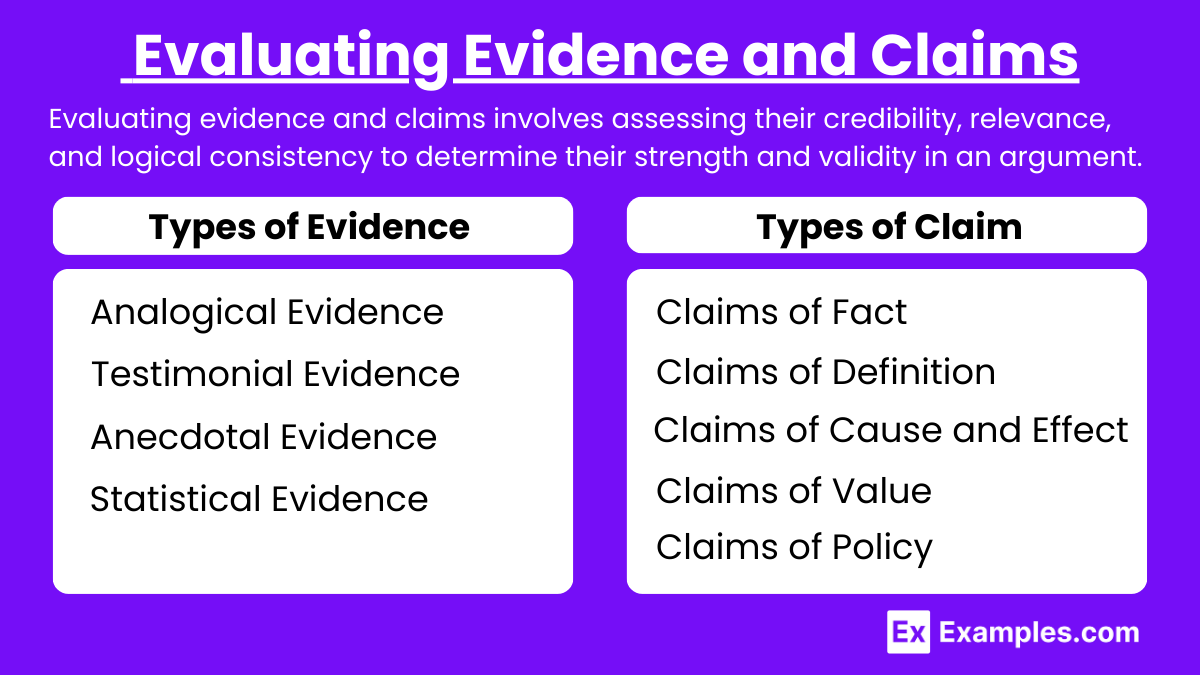In AP English Language and Composition, the ability to evaluate evidence and claims is a fundamental skill. This process involves assessing the quality, relevance, and reliability of the information presented to support an argument. Understanding how to critically analyze evidence and claims enables students to dissect complex texts, identify strong versus weak arguments, and construct persuasive essays of their own. By mastering this skill, students enhance their critical thinking abilities and improve their effectiveness as writers and analysts, which is essential for success on the AP exam and in broader academic and real-world contexts.
Free AP English Language and Composition Practice Test
Evaluating Evidence in a Text
Evaluating evidence in a text is the process of critically examining the information presented to support claims or arguments. This skill is crucial in AP English Language and Composition as it enables students to determine the strength and validity of an argument.
Types of Evidence
1. Statistical Evidence
Example: "According to the CDC, 70% of adults in the U.S. are overweight or obese."
Evaluation: Check the reliability of the source and the relevance of the statistic to the argument.
2. Anecdotal Evidence
Example: "A friend of mine switched to a vegan diet and saw remarkable health improvements."
Evaluation: Consider the anecdote's relevance and if it provides enough support for the argument. Anecdotes are often less reliable due to their subjective nature.
3. Testimonial Evidence
Example: "Dr. Smith, a renowned cardiologist, states that regular exercise can reduce the risk of heart disease."
Evaluation: Verify the credibility of the person giving the testimonial and their expertise on the subject.
4. Analogical Evidence
Example: "Just as a seed needs water to grow, a student needs a supportive environment to thrive."
Evaluation: Assess the strength of the analogy and whether it accurately represents the relationship it’s trying to convey.
Steps to Evaluate Evidence

1. Identify the Evidence
Types of Evidence: Look for different kinds of evidence such as statistics, testimonials, anecdotes, analogies, and factual data.
Example: "According to the CDC, smoking causes nearly 480,000 deaths each year in the U.S."
2. Determine the Source
Credibility: Assess the reliability and credibility of the source providing the evidence.
Example: A statistic from the CDC (Centers for Disease Control and Prevention) is credible because the CDC is a reputable public health institution.
3. Check Relevance
Relevance to the Claim: Ensure the evidence directly supports the claim it is supposed to back.
Example: If the claim is about the dangers of smoking, statistics on smoking-related deaths are relevant.
4. Evaluate Sufficiency
Amount of Evidence: Determine if there is enough evidence to convincingly support the claim.
Example: Multiple studies showing similar results strengthen the argument more than a single piece of evidence.
5. Assess Timeliness
Current Information: Check if the evidence is up-to-date and reflects the most recent data or research.
Example: A study on climate change impacts published in the last year is more relevant than one from a decade ago.
6. Identify Bias
Objectivity: Consider if the evidence is presented objectively or if there is potential bias.
Example: Evidence from a study funded by a tobacco company may be biased when discussing the effects of smoking
Criteria for Evaluating Evidence
1. Credibility
Definition: The trustworthiness and reliability of the source providing the evidence.
Evaluation: Check the author’s credentials, the publication’s reputation, and the reliability of the data.
Example: Evidence from peer-reviewed journals, government reports, and recognized experts is generally credible.
2. Relevance
Definition: The pertinence of the evidence to the claim being made.
Evaluation: Ensure the evidence directly addresses the claim and supports the argument effectively.
Example: Using health statistics to support a claim about public health policy.
3. Sufficiency
Definition: The adequacy of the amount of evidence to support the claim.
Evaluation: Assess whether there is enough evidence to convincingly support the claim. Multiple supporting data points are generally better.
Example: Several studies showing similar results provide stronger support than a single study.
4. Timeliness
Definition: The recency of the evidence.
Evaluation: Ensure the evidence reflects the most current data or research.
Example: Recent scientific studies on climate change are more relevant than older ones, given the rapidly evolving nature of the field.
5. Bias
Definition: The objectivity and impartiality of the evidence.
Evaluation: Consider whether the evidence is presented objectively or if there is a potential conflict of interest or agenda influencing it.
Example: Evidence from a study funded by an industry with a vested interest in the outcome may be biased.
6. Accuracy
Definition: The correctness and precision of the evidence.
Evaluation: Verify the evidence with other reliable sources to ensure it is factually correct.
Example: Cross-checking statistical data with official sources like government databases.
7. Representativeness
Definition: The extent to which the evidence reflects a larger population or set of circumstances.
Evaluation: Determine if the evidence is based on a representative sample or if it is an outlier.
Example: A survey conducted with a diverse, large sample size is more representative than one with a small, homogenous group.
Example for Evaluating Evidence
Evidence 1: Mental Health
Evidence: According to a study published by the American Psychological Association, teenagers who spend more than three hours per day on social media are at a higher risk of mental health issues such as depression and anxiety.
Evaluation: This evidence is strong because it comes from a reputable organization specializing in psychological research. The study’s specific focus on the amount of time spent on social media and its direct correlation with mental health issues makes it relevant and credible. Moreover, the study is recent, ensuring that the data reflects current trends and behaviors among teenagers.
Evidence 2: Academic Performance
Evidence: A report by the National Center for Education Statistics found that students who frequently use social media during study hours tend to have lower grades compared to those who do not.
Evaluation: This evidence is compelling because it is derived from a government agency that collects and analyzes education data, ensuring accuracy and objectivity. The direct link between social media use and academic performance provides clear support for the argument that social media negatively impacts teenagers' education.
Evidence 3: Social Skills
Evidence: A survey conducted by the Pew Research Center revealed that 60% of teenagers believe that social media has made it more difficult to interact face-to-face with their peers.
Evaluation: The evidence is persuasive as it is based on the perceptions of teenagers themselves, offering firsthand insights into how they feel about the impact of social media on their social skills. The Pew Research Center is known for its reliable and unbiased surveys, adding to the credibility of the evidence.
Evaluating Claims in a Text
In the realm of rhetoric and persuasive writing, the ability to evaluate claims critically is an essential skill. It allows readers to discern the validity of arguments, the reliability of evidence, and the logical coherence of the reasoning presented. In the context of AP English Language and Composition, this skill is paramount, as it empowers students to engage deeply with texts, scrutinizing the effectiveness and credibility of the authors' assertions. This essay will explore the process of evaluating claims by examining [Author’s Name]’s argument in [Title of the Text]. By dissecting the evidence, analyzing the reasoning, and considering potential counter arguments, we will uncover the strengths and weaknesses of the claims presented, ultimately determining the overall persuasiveness of the text.
Types of Claims
1. Claims of Fact
Claims of fact assert that something is true or not true. They are statements that can be verified through evidence and factual information.
Example: "The Earth is experiencing unprecedented levels of climate change, as evidenced by rising global temperatures and increased frequency of extreme weather events."
2. Claims of Definition
Claims of definition argue about the nature or classification of something. They often seek to define a term or concept in a particular way.
Example: "Plagiarism should be defined as any act of using someone else’s work without proper attribution, regardless of intent."
3. Claims of Cause and Effect
Claims of cause and effect argue that one thing causes another, or that certain effects result from specific causes.
Example: "Excessive screen time in children leads to various health issues, including poor vision, obesity, and impaired social skills."
4. Claims of Value
Claims of value evaluate or judge something based on a set of criteria or standards. They express an opinion about the worth, goodness, or morality of something.
Example: "The arts are an essential component of a well-rounded education, as they foster creativity and critical thinking."
5. Claims of Policy
Claims of policy advocate for specific actions or changes in policy. They often use claims of fact, definition, and value to support their recommendations.
Example: "To address the issue of student debt, the government should implement policies that provide free community college education."
Steps for evaluating claims

Step 1: Identify the Main Claim
Locate the primary assertion the author is making. This is often found in the thesis statement or the introduction.
Step 2: Determine the Type of Claim
Classify the main claim based on the types listed above. Is the author making a factual assertion, defining a concept, establishing a cause-and-effect relationship, evaluating something, or advocating for a policy change?
Step 3: Identify Supporting Claims
Identify the supporting claims that help build the argument. Determine their types and how they contribute to the main claim.
Step 4: Analyze the Evidence
Evaluate the evidence provided for each claim. Consider its credibility, relevance, and sufficiency.
Example for Evaluating Claims
Plastic pollution has become a significant environmental issue (Claim of Fact). It disrupts marine ecosystems and harms wildlife (Claim of Cause and Effect). Reducing plastic waste is crucial for preserving the planet's biodiversity (Claim of Value). Governments should ban single-use plastics to mitigate this problem (Claim of Policy)."
Identifying Claims:
Claim of Fact: Plastic pollution has become a significant environmental issue.
Claim of Cause and Effect: It disrupts marine ecosystems and harms wildlife.
Claim of Value: Reducing plastic waste is crucial for preserving the planet's biodiversity.
Claim of Policy: Governments should ban single-use plastics to mitigate this problem.


